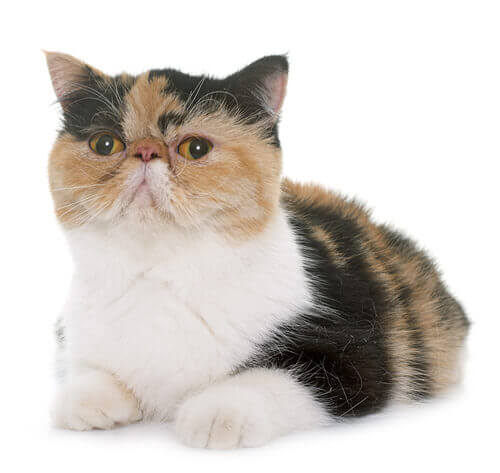
Known as the lazy man’s Persian, the Exotic Shorthair has the body type and easygoing nature of the Persian but without the coat length and need for daily grooming. With her thick, dense, plush short hair and round face, the Exotic Shorthair has a soft teddy bear look. This sweet feline is affectionate and loyal. The breed is athletic, fun-loving, yet also quiet and sensitive.
DID YOU KNOW? Originally the Exotic Shorthair was named Sterling due to the breed’s beautiful silver coat. They later were named Exotic Shorthair because the silver wasn’t a colour previously found in American Shorthairs, making it exotic.
The need-to-know
- Highly active and inquisitive cat
- Sociable and dependent cat
- Average build cat breed
- Requires grooming every week
- Great family cat
Personality

The Exotic Shorthair cat has the same gentle affectionate nature as it's longhaired cousins and is not as boisterous as many shorthair breeds. Exotic cats are quite happy to be left at home on their own and to lead a quiet life.
History and Origins

Country of Origin: America/Britain
The Exotic Shorthair cat breed is in every way a shorthaired Persian cat breed, so much so that it is included in the longhair section of cat shows. In America selective breeding of American Shorthair cats and Persian longhairs was undertaken to produce a cat that looked like the Persian cat in every way except for the coat. In Britain, British Shorthair cats were crossed with longhaired Persian cats in the same way. The coat, which is of medium length, is much easier to care for but still has the huge range of colours and patterns. The Exotic Shorthair cat was first seen in the 1960s and is becoming a very popular cat.
Nutrition and Feeding

Every cat is unique and each has their own particular likes, dislikes, and needs when it comes to food. However, cats are carnivores and every cat must obtain 41 different and specific nutrients from their food. The proportion of these nutrients will vary depending on age, lifestyle and overall health, so it's not surprising that a growing, energetic kitten needs a different balance of nutrients in her diet than a less active senior cat. Other considerations to bear in mind are feeding the right quantity of food to maintain 'ideal body condition' in accordance with feeding guidelines and catering to individual preference regarding wet or dry food recipes.
Other Information

Health and common issues
There area number of health problems associated with the Exotic Shorthair cat breed and its close relative, the Persian cat. Because the head shape has been shortened and the face flattened, there can be jaw deformities which can lead to dental disease and potential problems with eating and drinking. Small nostrils and a soft palate which is too long, can also lead to breathing problems. The tear ducts may not follow their natural path and so the eyes run and wet the face constantly – this can lead to skin rashes and sores on the face. The flat nature of face also increases the chances of eye disease. Exotic cats can carry a gene that leads to kidney failure (called autosomal dominant polycystic kidney disease) through the development of cysts in the kidney. This condition was found in more than a third of all Persian and Exotic shorthaired cats in the 1990s when screening tests became available. Using screening, breeders are now working to try to eradicate the problem – always ask the breeder to show the PKD certificates for the cats used to produce your kitten.
Best cat breeds for children
While this breed is not widely recognised as one of the best breeds for children, all cats are different and with the proper familiarisation may still be able to live with children.